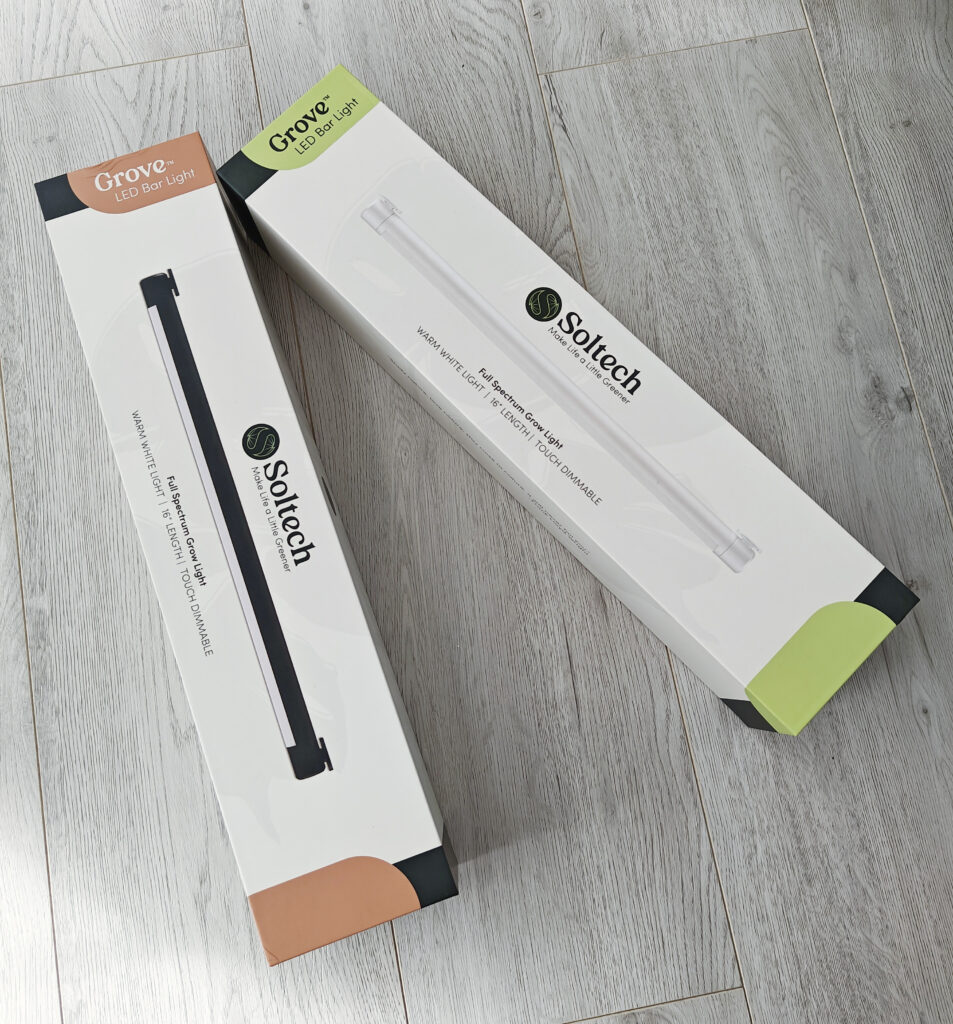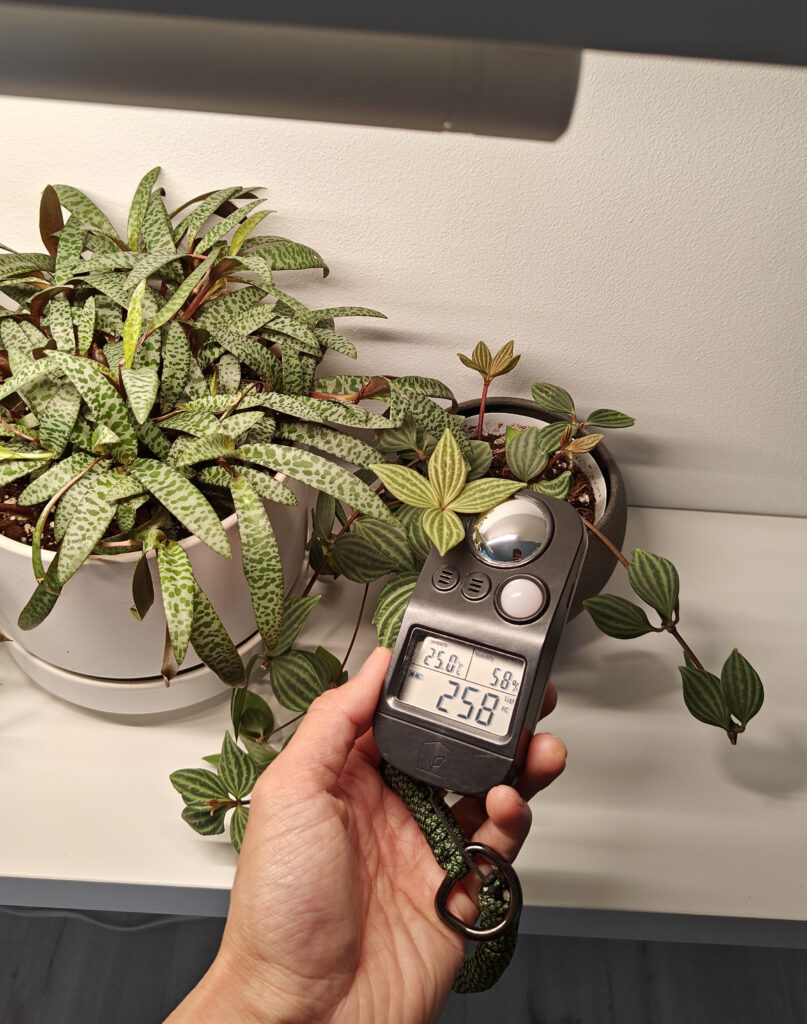Disclaimer: this is a paid partnership between Soltech Solutions and House Plant Journal. The products were given to House Plant Journal to provide an honest review. Using the links to purchase from Soltech supports my efforts to create educational content on House Plant Journal.
Get 15% off a Soltech grow light with my code: hpjsoltech15
(House Plant Journal is an affiliate partner with Soltech)

Impressive by build quality
Right from the unboxing and holding the unit in my hands, I was impressed with the build quality. The entire unit feels solid and nice to touch – there’s something satisfying about the feeling of the textured aluminum body that houses the LED chips.

The frosted cover is a nice touch that both hides the raw LED chips when the light is off or at the dimmest setting. The light is also more evenly distributed within the coverage area. The overall light housing is sleek and stylish – something you would want to display in your living room.

Check out the Grove LED Bar Light and get 15% off a Soltech grow light with my code: hpjsoltech15
(House Plant Journal is an affiliate partner with Soltech)
Operation
To turn the unit on or off, you double tap anywhere on the tube – about as fast as a double click on a mouse. To adjust the brightness, you double tap and hold, which will cause the brightness to go down or up by 10 levels. This is useful if your plant does not require the maximum brightness but the light is mounted in a small shelf (more on measuring and why this is so critical later).
To help you “set it and forget it”, Soltech includes a wall-mounted timer where you can set the daily on/off duration. Typical durations for foliage plants would be 12 to 18 hours per day, which depends on your desired Daily Light Integral (DLI) for your particular application.
The Light
The light appears as “warm white”, which is around 2500-3000K. This will be comfortable on your eyes and will look similar to your other household lights. The color temperature of typical “white” lights ranges from 2500K (“warm white”, orange tint like a fireplace), to 5000K (“cool white”, more blueish, sterile feeling). Some are even as high as 6500K, which is a very blueish light. In terms of growing houseplants, color temperature does not have a major impact on growth – the measured strength is what matters.
Measuring the strength of the light that reaches your leaves is critical – you wouldn’t use an oven without knowing at what temperature it should be set. Likewise, with grow lights, you need to measure the light reaching your leaves in order to set the distance and/or adjust the brightness correctly.
You can measure a white LED with a traditional light meter (in foot-candles, FC or lux) or a PAR Meter (in µmol/s/m², shortened to µmol) because FC and lux are well-correlated with PPFD. This is not the case with all types of artificial light sources: the discrepancy between FC and PPFD is bigger when measuring ceramic metal halide, high pressure sodium, fluorescent, or pure red/blue LED. The Soltech Grove LED Bar is a white LED light so you don’t need to worry about this – I will measure in FC.
In terms of spectrum, many people throw around the term “full spectrum”, but let me show you what it actually means using a spectrometer.



How to Use the Grove Bar Light
Very close range for small succulents: you could install it into a small shelf where the light would be within one foot of the plant, at maximum brightness. This could grow several small succulents very well.

I’m using the LTH Meter, the first device that measures light, temperature, and humidity all in one. I designed the LTH Meter to empower plant parents to be more informed about their environmental conditions.
Different plants at different strengths: I’ve set up the Grove LED light in a set of floating shelves in my living room. You can make use of the different strengths of light within the coverage area – higher light plants in the middle and lower light plants off to the sides.
When using grow lights, it is critical that you have a light meter so you know you’re placing the plant at the right distance – as you’ll see, mere inches can result in 2x or 3x difference in light levels even though the brightness setting of the light remained the same.
I have also created a reference table of light levels for various plants: Grow Light Strength Recommendations by Plant





Conclusion
After bringing in some of my favorite plants for the winter, I’m super excited to use the Soltech Grove LED Bar to keep them thriving *AND* stylish in my living room. The overall feel and build quality tells me this light will last many years.
Use my code: hpjsoltech15 – gets you 15% off at Soltech
(House Plant Journal is an affiliate partner with Soltech)
Calculations:
(1) 1200 FC x 12 hours
Convert FC to µmol/s/m²: 1200 x 0.2 = 240 µmol
Find total light for 12 hours: 240 x 3,600 x 12 = 10,368,000 µmol/day
Convert to mol: 10,368,000 / 1,000,000 = 10.368 ~ 10.4 mol/day
(2) 200 FC x 12 hours
Convert FC to µmol/s/m²: 200 x 0.2 = 40 µmol
Find total light for 12 hours: 40 x 3,600 x 12 = 1,728,000 µmol/day
Convert to mol: 1,728,000 / 1,000,000 = 1.728 ~ 1.7 mol/day
(3) 500 FC x 12 hours
Convert FC to µmol/s/m²: 500 x 0.2 = 100 µmol
Find total light for 12 hours: 100 x 3,600 x 12 = 4,320,000 µmol/day
Convert to mol: 4,320,000 / 1,000,000 = 4.32 ~ 4.3 mol/day
(4) 800 FC x 12 hours
Convert FC to µmol/s/m²: 800 x 0.2 = 160 µmol
Find total light for 12 hours: 160 x 3,600 x 12 = 6,912,000 µmol/day
Convert to mol: 6,912,000 / 1,000,000 = 6.912 ~ 6.9 mol/day
(5) 250 FC x 12 hours
Convert FC to µmol/s/m²: 250 x 0.2 = 50 µmol
Find total light for 12 hours: 50 x 3,600 x 12 = 2,160,000 µmol/day
Convert to mol: 2,160,000 / 1,000,000 = 2.16 ~ 2.2 mol/day
Article: references for DLI requirements by plant
If you’re looking for a logical and sensible approach to houseplant care, I’ve created the perfect online course for you:

